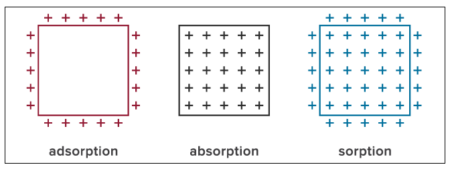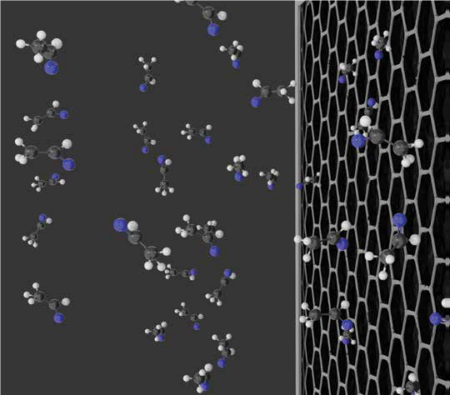 | > E&O/GL Insurance for Home Inspectors Competitive Rates, Broad Coverage, Free Risk Management, online inspection support for tough questions, discounts on education and more… Professional Coverage, Competitive Pricing Shop OREP today! |
Let’s Absorb Adsorption Together
By Greg Johns, WIN Home Inspection
Let me preface this by saying most professionals in the trades (including home inspectors and building inspectors) are not chemists, physicists, or molecular specialists. If you don’t get the concepts herein, or I fail to explain their conditions properly, that’s okay. There is a world of chemistry that needs and requires specialists—we don’t need to be them. I just want to expose more of us to basic premises that can and should help decision-making when designing, building, or inspecting structures.
In the physical world, where materials are felt, cut, and manipulated, it’s hard to pay attention to what is right there but not readily visible—namely: gases and chemistry. So, this is a walk-through to create awareness of how a solid, liquid, or gas responds to another solid, liquid, or gas related to material performance.
Perhaps the most accessible and best starting example would be liquid and tape flashings. In modern construction, we have become very reliant on liquid and tape flashing for helping to limit air and moisture (and pest) infiltration into our structures (because, don’t forget, our aim is to control the inside and keep the outside out when it comes to building a structure). Well, not all builders/trades professionals are on this bus yet, but the ranks appear to be increasing each year.
When a liquid or flashing tape is used, it relies on a chemical bonding of materials—adsorption; this is one of our key terms. Adsorption is the accrual of atoms, ions, and molecules on another surface in a bonding method. When liquid flashing is applied, the chemical concoction adheres to the surface of the other material. The liquid flashing does not fully penetrate or incorporate into the other material but bonds at the surfaces. This is adsorption for building materials (See Figure 1: The difference between Adsorption, Absorption, and Sorption). The other really important takeaway relates to too much of the adsorbate—the liquid flashing—being applied to the absorbent—the other material to which it is adhering. There is a finite layering that can be productive before the liquid flashing stops its intended adhering. Basically, you don’t have to apply (nor would it perform properly) three inches of liquid flashing along the sill/sheathing joint of a wall/ foundation assembly.

Figure 1: The difference between Adsorption, Absorption, and Sorption
If we look at flashing tape and adsorption, the same premise applies but a bit differently. You know how you may have heard, “You have to roll the tape,” by flashing tape manufacturers? Well, that’s because the rolling of the tape creates a sorption process whereby the chemicals of the adhesives in the tape “wet” into the tiny pores of the material to which it is adhering. In other words, the mechanical process of physically (think energy usage) wetting the tape by rolling helps to induce the adsorption of the adhesive onto the material at hand—wood, concrete, etc. The tape’s adhesive does not penetrate into the surface, but bonds at the teeny-tiny level to create the “long-term sticking.” This is the same thing that happens when activated charcoal filters your water, or when a carbon filter adsorbs gaseous pollutants from the air through an air purifier (See Figure 2: Carbon Filter Adsorbs Pollutants in Air Purifier).

Figure 2: Carbon Filter Adsorbs Pollutants in Air Purifier
(story continues below)
(story continues)
Now, perhaps you do a lot of reading and listening and have heard the ongoing rumblings of those nay-sayers who fear failure when relying on liquid or tape flashing. Chemically speaking, this would be desorption; for adsorption and surface bonding, it is the premise that what adheres can also come loose (with an investment of energy). Technically, this is an accurate fear; ongoing testing of tapes and liquid flashings continues to help determine long-term chemical bonds and what sort of stressors (think energies) can break those bonds and cause failure in flashing-related protections, which could lead to water infiltration and unhealthy issues developing in a structure. This is why the manufacturer’s literature is so vital—the manufacturer tells you what you can use their product with, how it must be used and when it will fail. If you don’t follow the recipe, don’t be surprised when your crepe eats like a pancake. As a home performance consultant, and a licensed home inspector, I cannot begin to extol the merits of reading all that tiny print. That’s my soapbox.
The other key term I intended to confuse and befuddle you regarding is absorption. If adsorption is surface adherence, then absorption is full-on “I’m going to gobble you up and put you in my belly.” Think of an alligator and a doe at the water’s edge. The doe goes into the alligator, not onto the alligator— a very crude metaphor, yes, but one that helps to express the point. The deer doesn’t adsorb to the alligator’s skin, although that would be interesting. Absorption is the process by which one material is fully incorporated within another, sometimes temporarily and sometimes permanently.
For building science and trades, think of moisture in a wall assembly, or in a floor assembly for those of us accustomed to wet crawlspaces. Unlike caulk, which only adheres (adsorption) to a surface, water can absorb into a material—such as wood or concrete. Have you ever seen a composite cement fiber board improperly installed and exposed to water? The rate is not fast, but absorption eventually reaches a point of equilibrium/saturation (a maximum concentration of sorts) that the material was never intended to manage. The related energies and stressors exert so much antagonism on the material that it starts to flake apart in these thin layers. That process starts with absorption and is one of the reasons why wood and cement-based composites are intended to be primed and sealed and separated from ground and roof surfaces (well, we have to introduce capillary action here to really explain it properly—we haven’t enough space remaining in this article).
Another ready example would be manufactured adhered stone veneer (a cement product) or brick veneer—both claddings (unless painted/sealed) readily absorb moisture from their exposed surfaces. The veneers will continue to absorb moisture until they reach an equilibrium. Then, either it stays (if it is raining) in the material, or it may begin to exit the material in the direction of less water. If the wind is driving the rain to the brick from the exterior, water may leave the brick on the interior side that faces away from the rain (more to less). And what’s on this side of the brick? The wall assembly. If this assembly lacks proper configurations to manage bulk water, the water may begin both the adsorption (weather resistive barrier) and absorption (wall sheathing) processes again. We all know what water does in wall assemblies, right? Right.
To further convolute, solar drive is an energetic process whereby the sun’s radiant heat physically forces the water onward/inward, which can have detrimental consequences for a wall’s performance. But, solar drive is not absorption. I am no chemist, but I suspect it is a variant of desorption since energy and heat alter the chemical relationships and drive one material out from within the other.
Please, don’t just take my word on any of this. Check with your local, friendly, neighborhood professional chemist. We all have those, right? Remember, you don’t have to be a chemist and you don’t need to be able to write a dissertation on any of this. What you should be able to do is have an inkling of an idea how this stuff works so you can make informed choices as a professional, so you can properly cite deficiencies or discovered issues, and so you can proficiently communicate to the client/consumer, thereby being respectful of their time and money.
About the Author
Greg Johns is the owner of a home inspection company in middle Tennessee called WIN Home Inspection. He is also a home diagnostic consultant and the current education director for the Home Inspectors of Tennessee Association. He works hard to keep his kids and flowers alive.
OREP Insurance Services, LLC. Calif. License #0K99465


